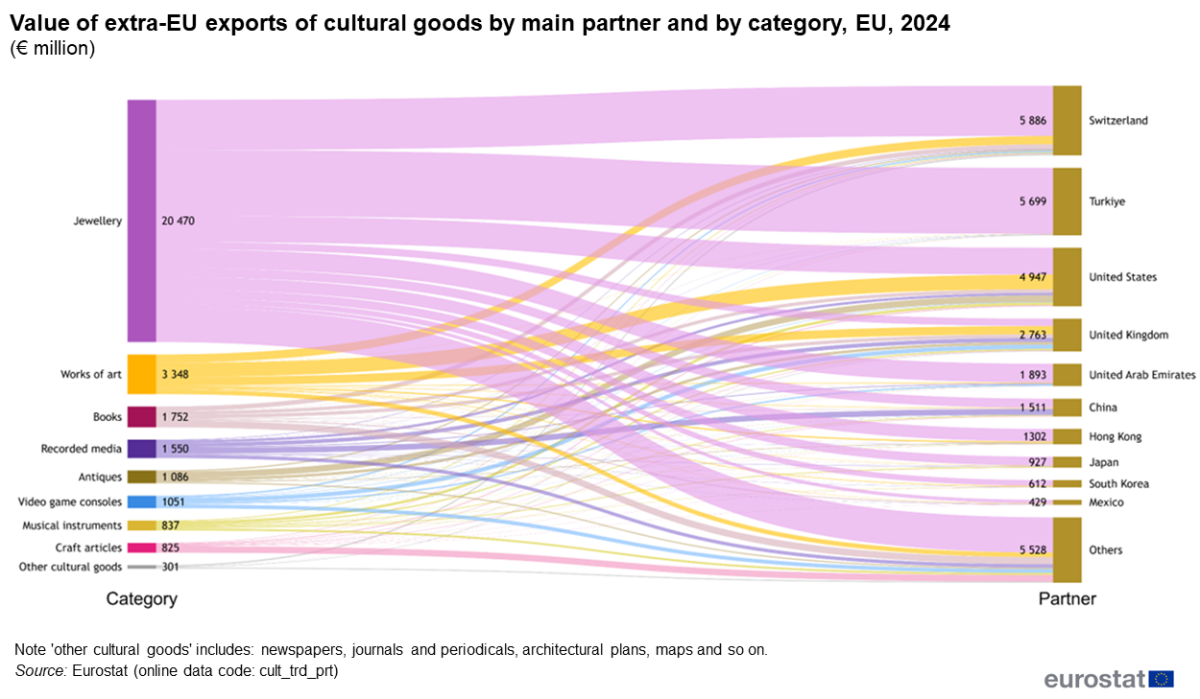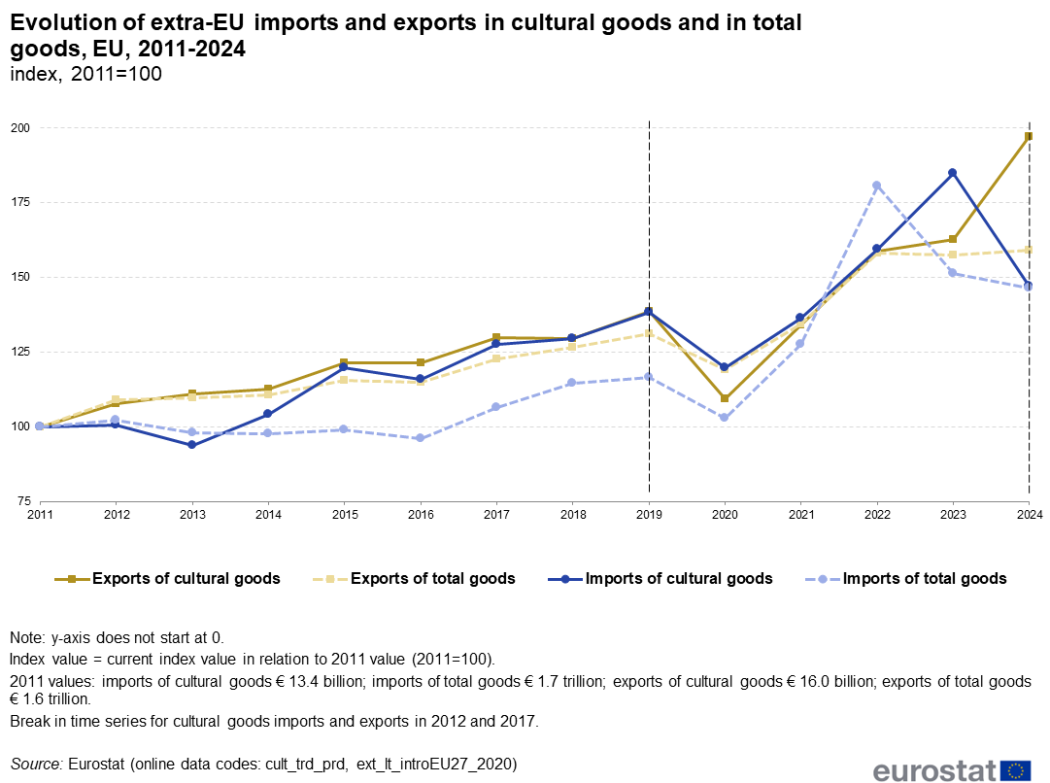In 2024, international trade of EU cultural goods is back to a surplus, according to Eurostat’s new article on Culture Statistics - international trade in cultural goods. For the year 2024, the trade balance for cultural goods increased to €11.9 billion compared to €3.7 billion in 2019 and the share of cultural goods in total extra-EU exports was around 1.2%. As the value of the exported cultural goods almost tripled since 2019, Eurostat's recent data add to the arguments on the important contribution of culture to the European economy.
The news for the positive trade balance comes amid growing efforts of the CCS civil society to secure EU funding dedicated to culture, following the Commission's proposal on the AgoraEU programme in the context of the upcoming MFF 2028-2034.
Here are some of the most recent Eurostat's culture statistics.
42% increase in cultural goods extra-EU exports value largely driven by Italian jewellery exports
A 42.3% increase is observed in 2024 on the value of EU exports of cultural goods out of the EU (extra-EU exports) reaching €31.5 billion, compared to €22.1 billion in 2019.
Jewellery made of precious metals and stones contributed €8.4 billion to this rise, “largely influenced by high Jewellery exports from Italy to Türkiye, reaching a historical maximum of €5.3 billion”, reads the Eurostat’s article.
As in 2019, the leading sectors remained jewellery, works of art and books, representing all together 81.2% of the total value of extra-EU cultural goods exports in 2024 (compared to 74.2% in 2019) (click on image to enlarge).

The highest relative change in value of extra-EU exports was observed for ‘Antiques' with an increase of 75.9%, followed by jewellery (+69.4%), photographic plates and films (+50.1%) and works of art (+41.1%), compared to 2019.
Declines were observed in 'Recorded media' (-€0.4 billion compared to 2019) and 'Books' (-€0.2 billion), partly counterbalancing overall increases.
An increase was observed in the total value of the imports of cultural goods as well, mainly driven by rising imports of works of art (+€1.6 billion). The highest decrease in imports was recorded in jewellery (-€0.8 billion).
Around 1.2% share of cultural goods in total exports of the EU
The highest share of cultural goods in total exports is observed in Italy reaching 2.7% (in 2024 from 1.8% in 2019). A slight increase of at least 0.1 percentage point was noted in Ireland, the Netherlands, Belgium, Romania and Luxembourg (click on image to enlarge).

A decrease of the share of cultural goods to total exports was observed to 19 countries, the largest in Poland (0.7% in 2024 from 1.4% in 2019).
Jewellery champions cultural trade balance in 13 EU countries
Jewellery contributed over half of the total value of cultural goods exports in Italy (87.9%), Cyprus (79.8%), France (64.7%) and Ireland (64.5%). While not exceeding 50% of total cultural goods exports value, jewellery remained the main category of cultural goods in Romania, Malta, Portugal, Luxembourg, Belgium, Spain, Denmark, Greece and Germany.
Works of art reached their highest share of 35.2% of cultural goods exports in Luxembourg, equal to the country’s jewellery share of exports (click on table to enlarge).

Books accounted for more than half the cultural goods exports value in Latvia (69.3%), Lithuania (58.0%) and Slovenia (53.7%), and led cultural goods exports in Hungary (41.9%), Poland (36.7%), Estonia (34%) and Croatia (30.8%).
Recorded media contributed the countries’ highest value of exported cultural goods in Finland (46.1%), Czechia (42.6%) and Austria (36.8%).
Video game consoles reached their highest shares in the Netherlands (46.4%), Bulgaria (45.2%), Slovakia (33.9%) and Sweden (32.9%).
Cultural goods exports back on track after the COVID-19 harsh hit
Taking an overview, cultural goods accounted for about 1.0% of total extra-EU exports during 2011-2024. A stable growth was observed during 2015-2019, sharply interrupted in 2020 reflecting the COVID-19 hit on international trade flows (click on image to enlarge).

A rebound appeared during 2021-2023 and in 2024 extra-EU exports of cultural goods sharply rose by 21.2%. At the same time, a sharp fall of imports by 20.4% is observed in 2024 after their 2023 peak and in the context of a relatively stable trend in total extra-EU exports (+1.1%).
More than 50% of all cultural goods exports to Switzerland, Türkiye and the United States
The leading cultural goods export market for the EU trade in 2024 was still Switzerland (€5.9 billion - 18.7% of extra-EU exports by value) despite a decrease of around 5 percentage points compared to 2019 (click on image to enlarge).

Türkiye followed, reaching €5.7 billion (18.1%) with the highest absolute increase observed (+€5.3 billion) compared to 2019 and third came the United States, reaching €4.9 billion (15.7%), with the second highest increase (+€1.9 billion).
Exports to each of the other trading partners of the EU were below 10%.
Find more here
Image 1 by Pexels from Pixabay - Free for use under the Pixabay Content License
Images and table - Courtesy of Eurostat













